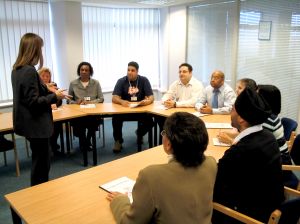Training Room Design — Seating Arrangements
Even if the activities of the learning session do not require changing the seating rearrangements, there are several reasons to do so:
- Learners are given a new perspective on the activity by sitting in a different part of the room.
- They get better acquainted with their peers.
- Learners are not consistently punished by being at greater distances from the screen or speakers.
- Small cliques do not arise—there is nothing wrong with cliques but in some cases they can become a problem by forcing their norms or agendas upon the entire group.
The following seating designs list some of the pros and cons of different learning rooms (Laird, 1985).
Note: In the following seating arrangements, 0 = the learners, x = the trainer, and -- equals a table.
Traditional Seating
x
O O O O O O O
O O O O O O O
O O O O O O O
O O O O O O O
O O O O O O O
- Best used for short lectures to large groups
- Communication tends to be one way
- Trainer cannot see the learners in the back
Modified Traditional
X
O O O O O O O O
O O O O O O O O
O O O O O O O O
O O O O O O O O
O O O O O O O O
- There is more participation
- Allows the trainer to see all the learners
- Reduces space between trainer and learners as trainer can move up aisle
- Best used for short lectures to large groups
Horseshoe
X
O O
O O
O O
O O O O O
- Non-verbally encourages participation by allowing eye contact between the trainer and all the learners
- The trainer is able to move closer to each learner
- Works well when all learners must be able to see a demonstration
- Works good when learners will be involved in large group discussions
Modular
O O
---- ---- ----
O | | O | |O O | | O
O | | O | |O | | O
---- ---- ----
0
X
---- ----
O | |O O | | O
O | | O | | O
---- ----
O
- Learners can work in small groups on exercises and projects
- Communication between trainer and learners is more difficult
- Trainer must move between groups during lectures and activities
- Good for courses that require a lot of group work
Circle
O O
O X
O O
O O
O O
O O
- Most democratic and unencumbered with no status symbol
- With no table each person is "totally revealed"
- Subtle nonverbal communications are possible
- Good for T-groups and sensitivity training
- There will be conversations, shorter inputs, and more members will participate when they sit at a round table rather than at a square table
Square
Solid Hole in middle
O O O O O X O O
---------- ----------
O | | O O | ------ | O
O | | O O | | | | O
O | | O O | | | | O
O | | X O | ------ | O
---------- ----------
O O O O O O O O
- More formality than a circle
- Nobody can see all the faces of the other participants
- Depending where visual aids are placed, one side may become the "head of the table"
- A solid table normally encourages more conversation
- Tables with a hole in the middle tends to make some people less talkative, while encouraging others to speak for longer periods of time
Rectangle
O O O O O
----------------
O | | O
O | | O
----------------
O O x O O
- The seats at the short dimensions of the table are often seen as leadership positions
- If used, the learners should be forced to take distinctly different positions every now and then (i.e. randomly shift the name cards)
- Fewer people can communicate face-to-face
Scatter-Shot
O O x O
O O O O
O O O O
O O O O O
O O
- May appear haphazard but good for experiential training
- Permits quick change of learner focus
- Produces tremendous investments of learner energy
- Works well with multiple role plays
- Learners can quickly form into large groups
- Bad for note taking
Next Step
Return to the Media, Strategies, & Methods page
Reference
Laird, Dugan (1985). Approaches To Training And Development. Reading, MA: Addison-Wesley.



